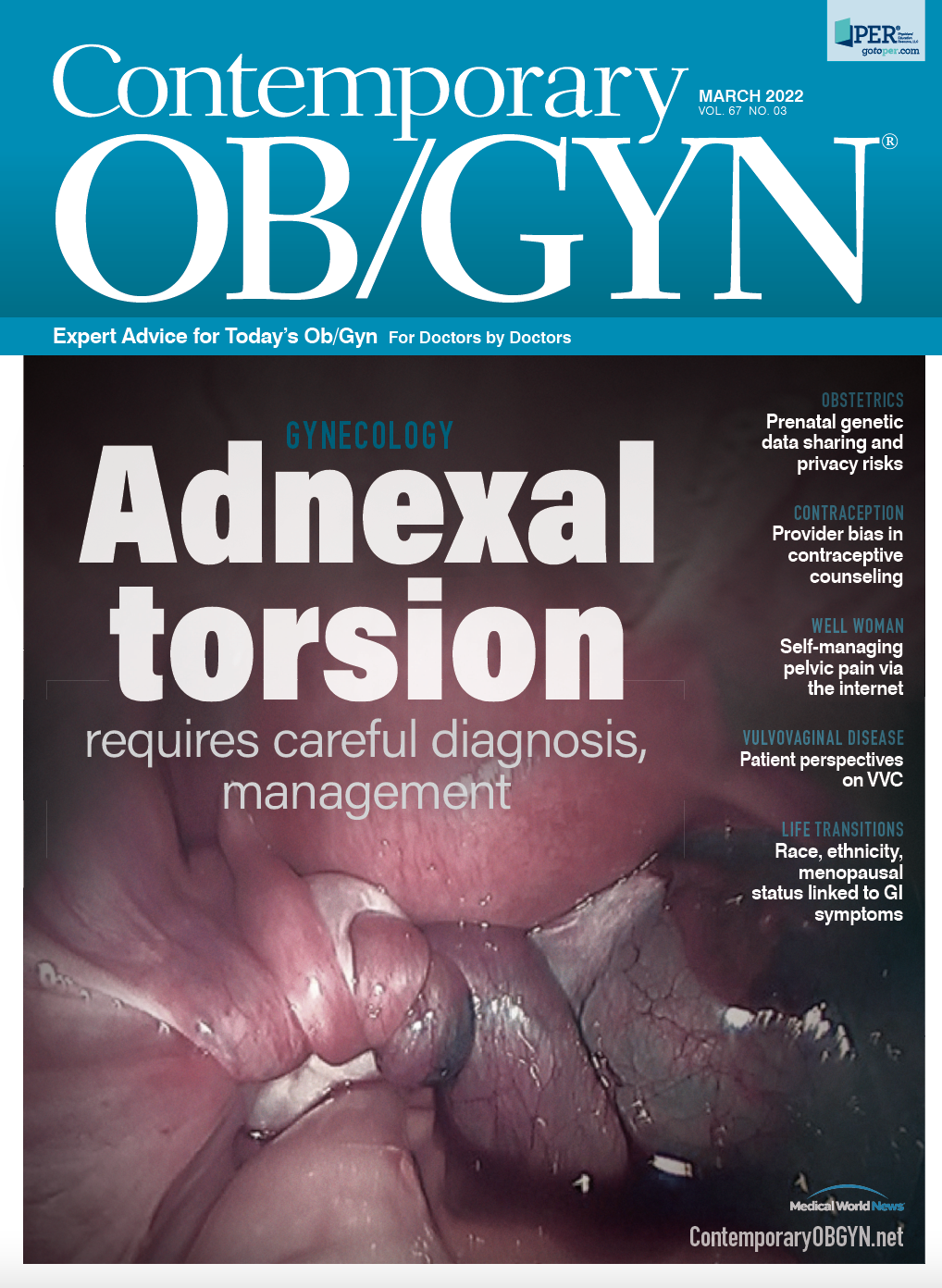The expert concluded the cause of the bowel injury was a thermal injury from the use of electrosurgery.
Delayed diagnosis of a bowel injury at laparoscopy
How important are the experts?
James M. Shwayder, MD, JD, is an adjunct professor at the University of Florida at the Gainesville Medical Center. He is a graduate of the University of Colorado School of Medicine and the University of Denver College of Law. As a nationally and internationally recognized expert in gynecology ultrasound and minimally invasive surgery, he actively consults on legal matters in medicine, including liability in ultrasound and gynecologic surgery, as well as issues surrounding privileging and insurance fraud.

A gravida 2, para 2 patient, age 46 years, presented with left-sided pelvic pain of acute onset. An office ultrasound revealed a 6-cm left ovarian cyst. The patient had a prior right salpingo-oophorectomy via laparotomy for an ovarian cyst. The patient underwent surgery 2 days later.
A Veress needle was used for insufflation, with a closed technique used for primary access. There were omental and bowel adhesions to the anterior abdominal wall in the left lower quadrant. A suprapubic trocar was placed under direct vision.
Bleeding was noted from this incision, which was controlled after removing the trocar with coagulation. Another incision was made below the first incision, and trocar insertion was accomplished without difficulty. The adhesions were sharply transected with laparoscopic scissors.
Because the cyst appeared to be simple, it was elected to aspirate the cyst, retrieving clear fluid. The intraperitoneal pressure was reduced with no bleeding identified. The trocars were removed with the incisions closed in the
usual fashion.
Six days after surgery, the patient presented to the emergency department with severe abdominal pain and bloating. She noted watery bowel movements and minimal appetite. Her temperature was 101.8 °F, with diffuse abdominal tenderness and few bowel sounds. A CT scan showed intraperitoneal air, interpreted as a bowel injury. The patient was taken to emergent surgery by her primary gynecologist and a general surgeon, and an ileal injury was identified.
The injury site was resected with a primary repair. The patient was hospitalized for 5 days for treatment of early sepsis. She fully recovered and returned to work 4 months after this surgery. The plaintiff filed a lawsuit for not recognizing the bowel injury, resulting in additional surgery, prolonged hospitalization, and prolonged recovery.
At trial, the plaintiff’s expert testified that the bowel injury occurred with insertion of the suprapubic trocar, injuring the bowel that was adherent to the anterior abdominal wall. Further, a Hasson technique should have been used for initial access, and if performed, this injury would not have occurred.
The defense expert stated that the technique to access the abdominal cavity was properly performed and within the standard of care. Further, the Hasson technique has been found to reduce incidence of vascular injury but not intestinal injury. The defense presented a visual reconstruction, demonstrating that the secondary trocar could not have caused the injury because, even if inserted completely, it would not reach the adhesions.
The plaintiff’s attorney asked the defense expert whether he had an opinion on the cause of the injury. The defense objected, asserting that their expert was testifying to rebut the plaintiff witness’ testimony, not to the causation of the injury, which would require speculation. The objection was sustained. The jury returned a verdict for the defense.
Learning points
Legal
In preparing the defense, a separate expert was retained. This expert concluded that the cause of the bowel injury was a thermal injury resulting from the use of electrosurgery during the scissor dissection of the adhesions, with thermal effect evident on the bowel.
Further, later in the surgical video, bipolar coagulation was used on the affected bowel. During deposition, the plaintiff’s expert failed to recognize this finding, focusing only on a presumed bowel injury during insertion of the secondary trocar.
The consulting expert educated the defense attorney about the frequency of bowel injuries, causation, and the timing of diagnosing bowel injuries following laparoscopy. During deposition and trial, the defense attorney carefully avoided additional questions regarding causation, thus confining the plaintiff expert’s opinion to a bowel injury caused by direct trauma.
As such, the defense attorney could retain an expert to rebut the plaintiff’s assertion. Had the plaintiff retained a more credible and compulsive expert, the result in this case may have been much different.
Medical
Indications
The indication for surgery was a 6-cm left ovarian cyst, presumably causing the patient’s pain. The ovarian cyst was a simple, unilocular cyst. Such cysts are universally benign, most resolving spontaneously (50%-70%). Those that persist have a low likelihood of malignancy.1 Appropriate diagnosis often avoids surgery altogether.
The International Ovarian Tumor Analysis group developed simple rules to assess the malignant potential of ovarian masses, which determined the current cyst was benign.2,3 When the risk of malignancy is indeterminate, applying the Assessment of Different NEoplasias model determines the patient-specific risk of malignancy, or, alternatively, one can refer the patient to an expert sonologist.4,5
Further, the Ovarian-Adnexal Imaging-Reporting-Data System (O-RADS) model developed a scoring system designating masses as normal, almost certainly benign, low risk, intermediate risk, or high risk for malignancy. O-RADS also recommends follow-up for premenopausal and postmenopausal patients.
Applying such models reduces surgical intervention, with the resultant risk of surgical complications. The use of expert sonologists and applying such models reduces the number of surgeries for malignancy from 9.1 per malignancy, as seen in the United States, to 2.3 per malignancy in specialized oncology centers in Europe.5 (Other European centers had a rate of 5.9 surgeries per malignancy.)
Bowel injury at laparoscopy
Bowel injuries occur in less than 1% of laparoscopic procedures, occurring more frequently during operative laparoscopy and by less experienced surgeons.6 Most injuries (54.9%) occurred during peritoneal access. An International Society for Gynecologic Endoscopy survey found that bowel injury was less frequent among experienced surgeons, yet the risk of injury during abdominal access was unrelated to experience.7
Electrosurgical injuries were the next most common cause (28.7%). A significant portion (40%) of bowel injuries are not recognized intraoperatively.8 The median time to diagnosis is 3 days, varying between 1 and 13 days.
Electrosurgical injuries to the small bowel present sooner than large bowel injuries, on average 4.8 days vs 10.4 days, respectively.9 The most common presenting symptoms include peritonitis, abdominal pain, fever, and abdominal distension.6
Of interest, leukocytosis and elevated C-reactive protein are found in only 10.5% of patients. Prompt diagnosis is critical, as all deaths after bowel injury were in patients with delayed diagnosis, with a mortality rate of 1 in 31.7
In this case, although the bowel injury was not recognized intraoperatively, emergency department evaluation and diagnosis were promptly made, and immediate surgical treatment performed, thus mitigating more devastating consequences.
References
- Modesitt SC, Pavlik EJ, Ueland FR, DePriest PD, Kryscio RJ, van Nagell JR Jr. Risk of malignancy in unilocular ovarian cystic tumors less than 10 centimeters in diameter. Obstet Gynecol. 2003;102(3):594-599. doi:10.1016/s0029-7844(03)00670-7
- Timmerman D, Ameye L, Fischerova D, et al. Simple ultrasound rules to distinguish between benign and malignant adnexal masses before surgery: prospective validation by IOTA group. BMJ. 2010;341:c6839. doi:10.1136/bmj.c6839
- Timmerman D, Testa AC, Bourne T, et al. Simple ultrasound-based rules for the diagnosis of ovarian cancer. Ultrasound Obstet Gynecol. 2008;31(6):681-690. doi:10.1002/uog.5365
- Van Calster B, Van Hoorde K, Valentin L, et al; International Ovarian Tumour Analysis Group. Evaluating the risk of ovarian cancer before surgery using the ADNEX model to differentiate between benign, borderline, early and advanced stage invasive, and secondary metastatic tumours: prospective multicentre diagnostic study. BMJ. 2014;349:g5920. doi:10.1136/bmj.g5920
- Glanc P, Benacerraf B, Bourne T, et al. First international consensus report on adnexal masses: management recommendations. J Ultrasound Med. 2017;36(5):849-863. doi:10.1002/jum.14197
- Llarena NC, Shah AB, Milad MP. Bowel injury in gynecologic laparoscopy: a systematic review. Obstet Gynecol. 2015;125(6):1407-1417. doi:10.1097/AOG.0000000000000855
- Brosens I, Gordon A, Campo R, Gordts S. Bowel injury in gynecologic laparoscopy. J Am Assoc Gynecol Laparosc. 2003;10(1):9-13. doi:10.1016/s1074-3804(05)60227-7
- Schrenk P, Woisetschläger R, Rieger R, Wayand W. Mechanism, management, and prevention of laparoscopic bowel injuries. Gastrointest Endosc. 1996;43(6):572-574. doi:10.1016/s0016-5107(96)70193-1
- Härkki-Sirén P, Kurki T. A nationwide analysis of laparoscopic complications. Obstet Gynecol. 1997;89(1):108-112. doi:10.1016/s0029-7844(96)00390-0

